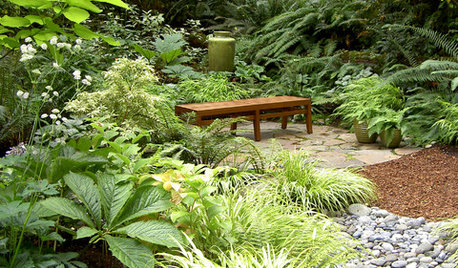Maranta's is wet soil
christine1950
10 years ago
Related Stories

GARDENING GUIDES10 Solutions for Soggy Soil
If a too-wet garden is raining on your parade, try these water-loving plants and other ideas for handling all of that H2O
Full Story
LANDSCAPE DESIGNFlood-Tolerant Native Trees for Soggy Soil
Swampy sites, floodplains, even standing water ... if you've got a soggy landscape, these trees are for you
Full Story
GARDENING GUIDESGardening Solutions for Heavy Clay Soils
What’s a gardener to do with soil that’s easily compacted and has poor drainage? Find out here
Full Story
GARDENING GUIDESGet the Dirt on Your Garden’s Soil
Understand how your soil supports your plants so you can ensure your garden’s success
Full Story
GARDENING GUIDESHow to Stop Worrying and Start Loving Clay Soil
Clay has many more benefits than you might imagine
Full Story
GARDENING GUIDESHow to Pick a Mulch — and Why Your Soil Wants It
There's more to topdressing than shredded wood. Learn about mulch types, costs and design considerations here
Full Story
GARDENING GUIDESGardening Solutions for Dry, Sandy Soils
Has your desert or beachy site withered your gardening creativity? Try these ideas for a beautiful, easy-care landscape
Full Story
GARDENING GUIDESHouzz TV: Make a Worm Bin for Rich Soil and Happy Plants
A worm-powered compost bin that can fit under a sink turns food scraps into a powerful amendment for your garden. Here’s how to make one
Full Story
GARDENING GUIDESGreat Garden Combo: 6 Beautiful Plants for a Shady, Wet Site
Transform a shade garden with moisture-loving golden grasses, textural leaves and a sprinkling of flowers
Full Story
GARDENING AND LANDSCAPINGGreat Design Plant: Bald Cypress
Enjoy this beautiful tree's feathery foilage, fall color and tolerance of wet and dry soils
Full StoryMore Discussions









petrushka (7b)
tapla (mid-Michigan, USDA z5b-6a)
Related Professionals
Essex Landscape Architects & Landscape Designers · Prairie Ridge Landscape Architects & Landscape Designers · Westwood Landscape Contractors · Maple Valley Landscape Contractors · Burien Landscape Contractors · Lake Zurich Landscape Contractors · Marlborough Landscape Contractors · Midland Landscape Contractors · Mission Landscape Contractors · Porterville Landscape Contractors · West Haverstraw Landscape Contractors · North Hills Landscape Contractors · East Patchogue Interior Designers & Decorators · Struthers Interior Designers & Decorators · Van Wert Interior Designers & Decoratorschristine1950Original Author
petrushka (7b)
tapla (mid-Michigan, USDA z5b-6a)
dbarron
christine1950Original Author